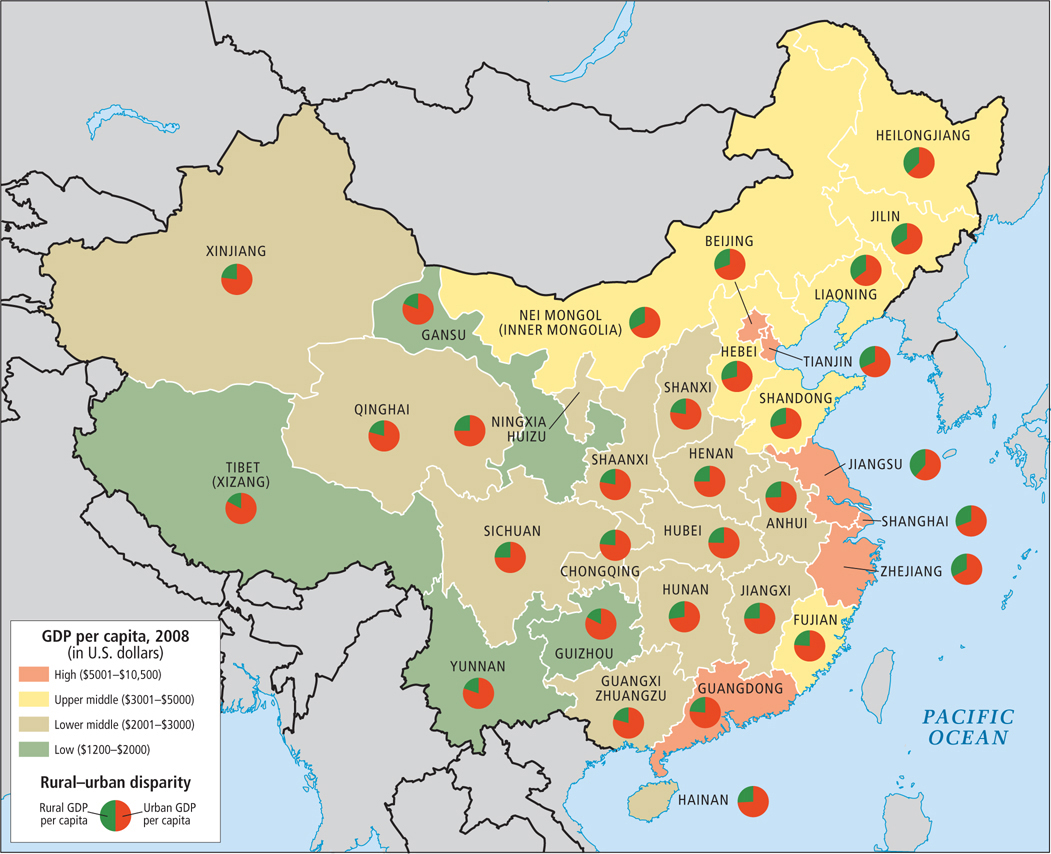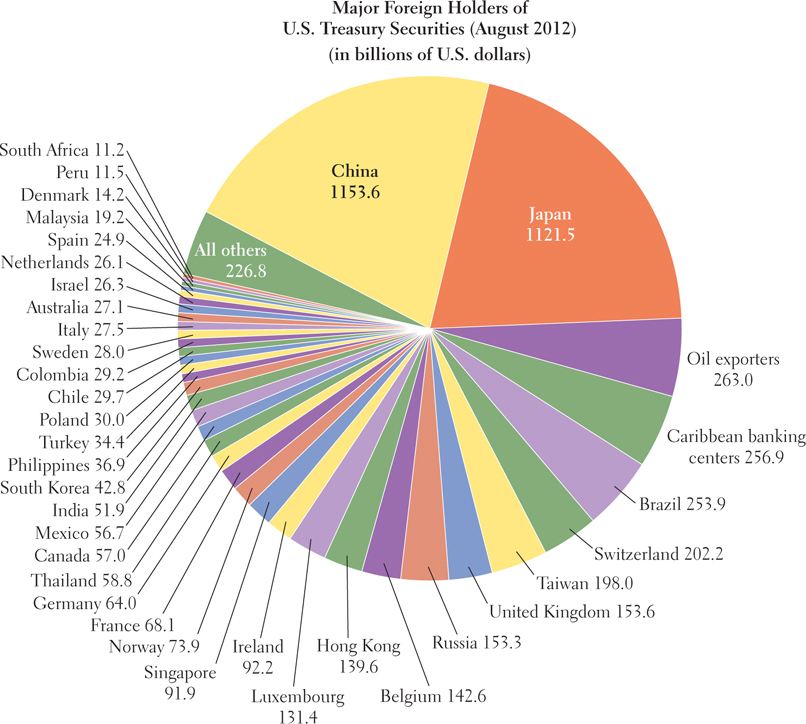9.5 GLOBALIZATION AND DEVELOPMENT
GEOGRAPHIC INSIGHT 2
Globalization and Development: East Asia pioneered a spectacularly successful economic development strategy that has transformed economies across the globe. Governments in Japan and then Taiwan, South Korea, and eventually China intervened strategically in the economy to encourage the production of manufactured goods destined for sale abroad, primarily to the large economies of North America and Europe.
After World War II, the countries of East Asia established two basic types of economic systems. The Communist regimes of China, Mongolia, and North Korea relied on central planning by the government to set production goals and to distribute goods among their citizens. In contrast, the governments of first Japan and then Taiwan and South Korea established state-
state-
export-
More recently, the differences among East Asian countries have diminished as China and Mongolia have set aside strict central planning and adopted many aspects of state-
The Japanese Miracle
Throughout the nineteenth century, the economies of Japan, Korea, and Taiwan were minuscule compared with China’s. During the twentieth century, though, all three grew tremendously, in part because of ideas that originated in Japan.
Japan Rises from the Ashes Japan’s recovery after its crippling defeat at the end of World War II is one of the most remarkable tales in modern history. Except for Kyoto, which was spared because of its historical and architectural significance, all of Japan’s major cities were destroyed by the United States. Most notably, the United States bombed Hiroshima and Nagasaki with nuclear weapons, and leveled Tokyo with incendiary bombs.  205. SURVIVORS RECALL THE NUCLEAR BOMBING OF HIROSHIMA
205. SURVIVORS RECALL THE NUCLEAR BOMBING OF HIROSHIMA
Key to Japan’s rapid recovery was its state-
The government-
Productivity Innovations in Japan Over the years, Japan has made two major innovations in manufacturing that have boosted its productivity and been diffused to other industrial economies, changing the spatial arrangements of industries. The just-
just-

A related innovation is the kaizen system of continuous improvement in manufacturing and business management. In this system, production lines are constantly surveyed for errors, which helps ensure that fewer defective parts are produced. Production lines are also constantly adjusted and improved to save time and energy. Both the just-
kaizen system a system of continuous manufacturing improvement, pioneered in Japan, in which production lines are constantly adjusted, improved, and surveyed for errors to save time and money and ensure that fewer defective parts are produced
Mainland Economies: Communists in Command
After World War II, economic development on East Asia’s mainland proceeded on a dramatically different course than it did in Japan. Communist economic systems transformed poverty-
By design, most people in the communist economies could not consume more than the bare necessities. On the other hand, the policy—
The Commune System When the Communist Party first came to power in China in 1949, its top priority was to make monumental improvements in both agricultural and industrial production. The Communist governments in North Korea and Mongolia held similar goals, though these countries had much smaller populations and resource bases to work with.
In the years following World War II, an aggressive agricultural reform program joined small landholders together into cooperatives so that they could pool their labor and resources to increase production. In time, the cooperatives became full-
The Chinese commune system met with several difficulties. Rural food shortages developed because farmers had too little time to farm. They were required to spend much of their time building roads, levees, terraces, and drainage ditches, or working in the new rural industries. Local Communist Party administrators often compounded the problem by overstating harvests in their communes to impress their superiors in Beijing. The leaders in Beijing responded by requiring larger food shipments to the cities, which caused even greater food shortages in the countryside.
Although the Chinese agricultural communes were inefficient and created devastating food scarcities during the Great Leap Forward, they did eventually result in a stable food supply that kept Chinese people well fed.
In North Korea, the Communists have pushed military strength at the expense of broader economic development. Agriculture has been so neglected that production is precarious, with food aid from its immediate neighbors or the United States a yearly necessity and famine a constant threat. In recent years, North Korea has used rocket launchings, nuclear tests, and even the threat of war to intimidate its neighbors, and it is selling its military technology abroad to pay for its food imports. Intermittently, the U.S. government suspends food aid to encourage more peaceful policies from the North Korean leadership, but with limited results.
In Mongolia, Communist policy followed the Soviet model of collectivization, though it was tailored to Mongolia’s economy, which at the time was largely one of herding and agriculture. There were minimal changes to the nomadic pastoralist way of life, but the role of mining and industry was emphasized, and the herding and forestry contributions to GDP declined to less than 20 percent.
Focus on Heavy Industry The Communist leadership in China, North Korea, and Mongolia believed that investment in heavy industry would dramatically raise living standards. Massive investments were made in the mining of coal and other minerals and in the production of iron and steel. Especially in China, heavy machinery was produced to build roads, railways, dams, and other infrastructure improvements that leaders hoped would increase overall economic productivity. However, much as in India (see Chapter 8), the vast majority of the population remained impoverished agricultural laborers who received little benefit from industries that created jobs mainly in urban areas. Not enough attention was paid to producing consumer goods (such as cheap pots, pans, hand tools, and other household items) that would have driven modest internal economic growth and improved living standards for the rural poor. Even in the urban areas, growth remained sluggish because, as also was the case in the Soviet command economy, small miscalculations by bureaucrats resulted in massive shortages and production bottlenecks that constrained economic growth.
Struggles with Regional Disparity For centuries, China’s interior west has been poorer and more rural than its coastal east. The interior west has been locked into agricultural and herding economies, while the economies of the east have benefited from trade and industry in even the most restricted times. The first effort to address regional disparities, right after the revolution, was an economic policy that focused on a combination of investment from the central government and the development of regional self-
regional self-
Economic Reforms in China
In the 1980s, China’s leaders enacted economic reforms that changed the country’s economy in five ways. First, building on Communist-
responsibility system in the 1980s, a decentralization of economic decision making in China that returned agricultural decision making to the farm household level, subject to the approval of the commune
regional specialization specialization (rather than self-
This five-

China’s economic reforms have transformed not only China’s economy but also the economies of wider East Asia and indeed the whole world. Today China is the world’s largest producer of manufactured goods, supplying consumers across the globe. Of the other Communist-
East Asia’s Role as Mega-

East Asians are able to use their reserves to finance development elsewhere in the world, thereby securing privileged trade deals. In recent years, China’s lending to developing countries has outpaced even that of the World Bank. Often these loans are made in return for guarantees that the recipient country will supply China with needed industrial materials, especially fossil fuels.
THINGS TO REMEMBER
GEOGRAPHIC INSIGHT 2
Globalization and Development East Asia pioneered a spectacularly successful economic development strategy that has transformed economies across the globe. Governments in Japan and then Taiwan, South Korea, and eventually China intervened strategically in the economy to encourage the production of manufactured goods destined for sale abroad, primarily to the large economies of North America and Europe.
Japanese management innovations known as the just-
in- time and kaizen systems were so successful that they diffused and created clusters of economic activity throughout the world. After World War II, Communist economic systems transformed poverty-
ridden China, Mongolia, and North Korea. Private property was abolished and the state took full control of the economy, loosely following the example of the Soviet centrally planned economy. By design, most people in the Communist economies could not consume more than the bare necessities, but the policy—
called the iron rice bowl in China— of guaranteeing nearly everyone a job for life, sufficient food, basic health care, and housing was better than what they had before. In the 1980s, China’s leaders enacted reforms that changed the country’s economy, enabling China to become the world’s largest producer of manufactured goods, supplying consumers across the globe.
Because China and Japan now own about 20 percent of U.S. public debt, many people are worried that either country could destabilize the U.S. economy by selling or refusing to buy more U.S. debt. However, such an event is highly unlikely.